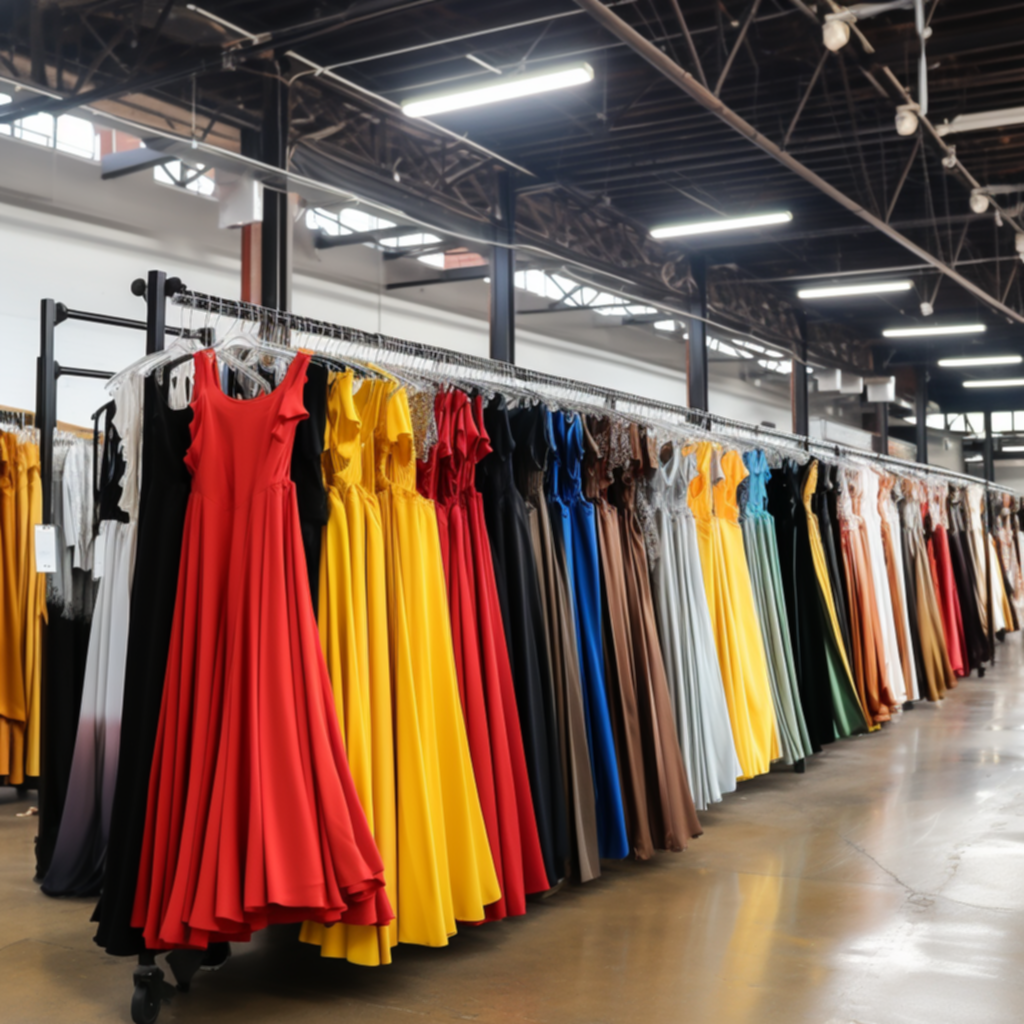Building a Successful Wholesale Clothing Business


Starting a wholesale clothing business is an exciting and potentially lucrative venture, especially if you have a keen eye for fashion and a drive for business success. The clothing industry is ever-evolving, with new trends and styles emerging all the time. By positioning yourself as a wholesale supplier, you can cater to retail businesses, providing them with a steady supply of fashionable clothing at discounted prices.
However, the road to a successful wholesale clothing business requires careful planning, dedication, and a clear understanding of the market and the latest fashion trends. In this guide, we'll walk you through the key steps to create a thriving wholesale clothing business that stands out from the competition. From conducting market research to sourcing quality products, building your brand identity, and marketing your business effectively, we've got you covered.
Conduct Market Research
a. Identify Target Market
The first step in creating a successful wholesale clothing business is to identify your target market. Who are the retail businesses you'll serve, and what are their needs? Are they boutique shops catering to high-end fashion, or do they cater to budget-conscious shoppers? Understanding their specific needs and preferences will allow you to provide them with the right products.
b. Analyze Competition
Your next step should be to analyze your competition. Who are the other wholesale clothing suppliers in your market? What do they offer, and what sets you apart? By conducting a thorough competitor analysis, you can identify gaps in the market and opportunities to differentiate your business.
c. Identify Trends
Understanding the latest fashion trends is crucial in the clothing industry. You need to be aware of what's in style and what's falling out of favor. Subscribe to fashion magazines, attend industry events, and follow influential fashion blogs and social media accounts. Keeping your finger on the pulse of the industry will allow you to stock the most sought-after clothing items.
Creating Your Brand Identity
a. Decide on a Niche
Choosing a niche is a fundamental step in creating a successful wholesale clothing business. Do you want to specialize in men's, women's, or children's clothing? Perhaps you want to focus on a specific style, like sportswear, casual wear, or formal wear. By selecting a niche, you can better target your marketing efforts and establish yourself as an expert in a particular area.
b. Branding
Your brand is more than just a name and a logo. It represents your business's identity, values, and promises to your customers. Think about the message you want to convey and the image you want to project. Are you a luxury brand, or do you offer affordable, everyday wear? Your branding should reflect your target market and the unique selling proposition (USP) that sets you apart from competitors.
c. Logo and Design Elements
Your logo and other design elements should be a reflection of your brand identity. Choose colors, fonts, and shapes that convey your brand's personality and appeal to your target audience. A well-designed logo can help create a strong impression and build recognition among your customers. Remember, consistency is key. Use your branding elements consistently across all your marketing materials and communications.
Sourcing Quality Products
a. Identify Reliable Suppliers
Sourcing quality products is a crucial step in establishing a successful wholesale clothing business. It would help if you had reliable suppliers who can consistently provide you with high-quality products. To find reputable suppliers, consider attending industry trade shows, getting recommendations from industry contacts, or using online directories and platforms such as Alibaba and Global Sources. Before establishing a relationship, check suppliers' references, reviews, and track record.
b. Assess Quality and Pricing
When evaluating potential suppliers, request product samples to assess the quality of their clothing. Consider factors such as fabric, stitching, and overall craftsmanship. In addition to quality, you'll need to assess their pricing. Determine if their cost allows you to make a reasonable profit while offering competitive prices to your customers. Also, consider other factors like minimum order quantities, payment terms, and delivery timelines. Make sure to negotiate favorable terms with your chosen suppliers.
Setting Up Your Business
a. Legal Requirements
Before you start selling, you need to meet certain legal requirements. Register your business with the appropriate authorities and obtain any necessary licenses and permits. Depending on your location, you might need a business license, sales tax permit, or employer identification number (EIN). Consult with a legal professional to ensure you're compliant with local, state, and federal regulations.
b. Business Plan
A well-thought-out business plan is essential for any successful business venture. Your business plan should outline your goals, target market, competition, pricing strategy, marketing plan, and financial projections. A business plan not only helps you stay focused and organized but is also essential when seeking financing from banks or investors.
c. Financial Planning
Proper financial planning is crucial for the success of your wholesale clothing business. Create a budget that includes startup costs, operating expenses, and projected revenue. Monitor your cash flow carefully and keep a close eye on your expenses. Ensure you have enough capital to cover your initial costs and keep your business running until you start generating a profit. Consider opening a separate business bank account to keep your personal and business finances separate.

Marketing and Promotion
a. Digital Marketing
Digital marketing is a powerful tool for promoting your wholesale clothing business. Utilize search engine optimization (SEO) techniques to increase your website's visibility on search engines. Create engaging and informative content that appeals to your target audience and showcases your expertise. Consider running pay-per-click (PPC) ads to drive targeted traffic to your site. Also, consider using email marketing to keep in touch with potential and existing customers, offering promotions or updates on new products.
b. Social Media Presence
Social media platforms like Instagram, Facebook, and Pinterest are great for showcasing your products and engaging with your audience. Share high-quality images of your clothing, behind-the-scenes glimpses of your business, and customer testimonials. Consider collaborating with influencers to extend your reach. Social media is also a great way to keep your audience updated on new arrivals, promotions, and industry trends.
c. Trade Shows and Events
Trade shows and industry events offer an excellent opportunity to showcase your products and connect with potential customers and industry peers. Consider setting up a booth at relevant trade shows to display your products and distribute marketing materials. Engage with attendees, answer their questions, and establish connections that can lead to lasting business relationships. Also, attend industry events to stay updated on trends and gain valuable insights.
Building Customer Relationships
a. Customer Service
Providing exceptional customer service is crucial for building strong relationships with your customers. Ensure that your customers have a seamless experience, from placing an order to receiving their products. Respond promptly to inquiries, address concerns, and resolve issues quickly and professionally. By providing excellent customer service, you can earn your customers' trust and build a loyal customer base.
b. Retention Strategies
Building long-term relationships with your customers is essential for the success of your wholesale clothing business. Implement customer retention strategies that encourage repeat business. Offer loyalty programs, exclusive discounts, or early access to new arrivals for returning customers. Regularly check in with your customers to ensure their needs are being met and to get feedback on your products and services. By prioritizing customer satisfaction and building lasting relationships, you can create a strong foundation for your business.
Scaling Your Business
a. Expand Your Product Line
Once your business is established and you have a loyal customer base, consider expanding your product line. Introduce new styles, fabrics, or categories that complement your existing offerings. Expanding your product line can help you attract new customers and increase sales among your existing customers. However, make sure to conduct market research and test new products carefully before making significant investments.
b. Diversify Your Customer Base
Diversifying your customer base is another way to scale your wholesale clothing business. Consider targeting different types of retailers or exploring new markets, such as international markets or online retailers. By expanding your customer base, you can reduce your reliance on a few key customers and increase your revenue.
c. Streamline Operations
As your business grows, it's essential to streamline your operations to handle the increased volume efficiently. Invest in tools and technologies that can help you manage your inventory, process orders, and track your finances more effectively. Consider hiring additional staff or outsourcing certain tasks, such as logistics or marketing. Streamlining your operations will enable you to handle the increased demand while maintaining a high level of customer service.
Conclusion
Starting and scaling a wholesale clothing business requires dedication, research, and a solid understanding of the market. By identifying your niche, sourcing quality products, and building strong customer relationships, you can create a successful and sustainable business. Remember, the fashion industry is constantly evolving, so stay on top of trends and adapt to changes in the market. With careful planning, hard work, and a passion for fashion, you can build a thriving wholesale clothing business.

FAQs
Q: How do I find reliable suppliers for my wholesale clothing business?
A: Consider attending industry trade shows, getting recommendations from industry contacts, or using online directories and platforms such as Alibaba and Global Sources. Before establishing a relationship, check suppliers' references, reviews, and track record.
Q: How can I differentiate my wholesale clothing business from competitors?
A: Identify a niche that appeals to your target market, create a strong brand identity, offer quality products, and provide exceptional customer service. Understand your competitors' offerings and focus on what sets you apart.
Q: How can I effectively market my wholesale clothing business?
A: Utilize digital marketing techniques such as SEO, content creation, and PPC ads. Establish a strong social media presence and engage with your audience. Consider setting up a booth at trade shows to showcase your products and connect with potential customers.
Q: How can I build strong customer relationships in the wholesale clothing industry?
A: Offer exceptional customer service, respond promptly to inquiries, and address concerns professionally. Implement customer retention strategies, such as loyalty programs and exclusive discounts. Regularly check in with your customers to ensure their needs are met and get feedback.
Q: How can I scale my wholesale clothing business?
A: Consider expanding your product line, diversifying your customer base, and streamlining your operations. Conduct market research and test new products before making significant investments. Invest in tools and technologies to manage your inventory, process orders, and track finances more effectively.






-500x500.jpg)
-500x500.jpg)
-500x500.jpg)
-500x500.jpg)
-500x500.jpg)